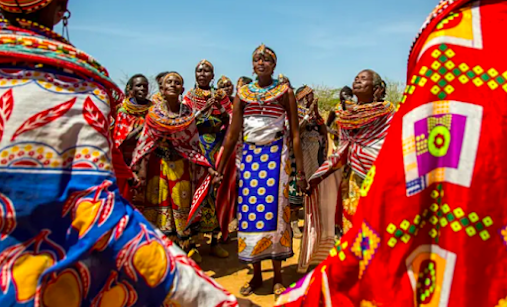Some context
Women are far too often overlooked. It wasn’t until the 1970s, in light of Western feminist movements, that global development agendas paid attention to their issues (
Allély et al, 2002). In 1975, the United Nations (UN) held its first-ever Women’s World Conference. The first key acknowledgement of women and their inextricable relationship with water occurred in 1992, at the Dublin conference (
Allély et al, 2002). It highlighted the need for ‘women to participate in all levels of water resource programmes, including decision-making and implementation’ (
UN, 1992).
In 1995, the UN then established that despite such efforts to acknowledge women in their policies, their voices were still not being heard (Allély et al, 2002). To tackle this, they held forums alongside conferences where non-governmental organisations (NGOs) were brought together, combining bottom-up and top-down approaches (Allély et al, 2002). In 1996, they successfully organised a 5-day event in Burkina Faso, where women from 150 rural organisations were able to discuss development policies in a ‘less formal, more decentralised framework’ (Allély et al, 2002).
Simply including women in policy frameworks ‘is not enough’ to dismantle the structural barriers blocking them from taking part (Lasiter and Stawicki, 2014). For such policies to achieve success, a ‘contextually specific understanding of who women are, what they do, what they care about’, and the ‘socio-cultural constraints and opportunities’ which affect their participation is paramount (Lasiter and Stawicki, 2014). The Global Water Partnership (GWP) realised this when they included gender sensitivity as a core component for maximising social welfare (Prakash, 2007). The GWP’s Integrated Water Resources Management (IWRM) in Ghana found that, during a workshop for their Volta-Basin development project in the Upper Eastern Region (UER), many of the partners had little understanding of women’s issues (Lasiter and Stawicki, 2014). It is clear that for there to be real change and genuine inclusion of women, their voices must be heard!

Why don’t women participate?
Achieving equality of men and women in positions of power is a global struggle, and it largely boils down to patriarchal cultural norms. In Africa, many male-dominated societies prevent women from working in the public sphere, disempowering them from taking on authoritative roles (
Svahn, 2011). Additionally, their domestic responsibilities can inhibit them from working or attending school as young girls. Such time-constraints can further explain women’s lower, on average, literacy rates. Low literacy rates reduce employability. There is a ‘need to improve women’s rights to, and attendance in, education’ (
Svahn, 2011).
Another explanation for low rates of female participation is the failure of many Water User Associations (WUAs) to address the multiple uses, and users, of water supplies (
IFAD, 2007). Lacking female representation in WUAs can impact the outcome of large scale water projects. This was the case in the Kano Plains in Kenya; men wanted water for cattle, and women needed it for washing clothes and dishes (
FAO, 2003) – not all needs were met.
There is an intrinsic link between land ownership and water access in developing countries (
IFAD, 2007). In Sub-Saharan Africa, women’s land-owning rights are insecure and often dependent on their marital status or male relations (
IFAD, 2007). Furthermore, financial institutions often regard women as ‘uncreditworthy’, disabling them from acquiring their own land (
IFAD, 2007). Without land tenure, it is harder for women to attend WUAs and share opinions.
Lack of acknowledgement by governments is also a factor in the unequal participation of women. All barriers mentioned above highlight the need for governments to take action. A study conducted in Ghana indicated the need for legal reform to increase female participation in water management (
Svahn, 2011).
To conclude:
In this post, I have explained why women's rights need to be
effectively acknowledged in water development programmes. Women cannot be solely "included" in top-down global initiatives, as it is hard to know what this inclusion actually means (
Lasiter and Stawicki, 2014). I, therefore, believe that a combination of top-down and bottom-up approaches is necessary through the incorporation of participatory development. As I mentioned above, a well-rounded understanding of women is needed if we are to solve their issues; the only way to gain such an understanding is to talk to the women themselves! Follow my next post where I will be evaluating the success of Water User Associations.



Amazing stuff. I think this blog entry really shows your perspective on things. You've given a detailed account about policy and the role of women in development. But where this post shines is your critique of the policy's. Keep up the great work and be critical!
ReplyDeleteThank you Nasir!
Deleteexcellent post, i like that you clearly laid out the points you were trying to make and used headings to clearly illustrate this. you have been detailed throughout in your account on the role of policy and women in development. really great post!
ReplyDeleteThank you Maha!
DeleteAlthough such schemes mean well, you have exemplified how important it is to still critically examine their overall advantages but also specific disadvantages that transpire towards groups of people, eg women. You have allowed us to understand how ingrained socio-cultural norms where men are 'superior' to women and head many of the decisions made, still exist within schemes that are meant to be aiding women. Great thinking point! You will have made a lot of people re-evaluate their stance...and for good reason!
ReplyDelete